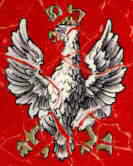
Home
Pilot
Escape
303 Squadron 1
303 Squadron 2
A New Home
and Finally
Links
Contents
| |
303 Squadron...
| Mirek had completed basic
orientation quickly, but as with so many Poles (and Czechs, the Dutch, the
French), RAF Fighter and Bomber Command were not over eager to use them.
Behind the excuse of "language difficulties", the RAF slowed
down the rate of establishment of Polish squadrons and delayed further
their activation. The truth was that the British thought that these men,
"having tasted defeat", would not be up to the task. The fall of
France in June 1940 and the beginning of the onslaught on the British
southern airfields during July and August 1940 did nothing to
persuade the RAF otherwise. |
| His Pilot's Flying Log Book
shows that he finally got his hands on aircraft. Between 23rd July 1940
and 11th August he rotated through the Tiger Moth, the Hawker Hector (a
Hind variant), the Fairey Battle and finally... the Hurricane Mark I. |
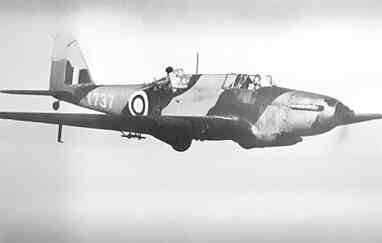
Fairey
Battle, Mirek's first taste of monoplane flight in England |
On 2nd August
1940, the Polish Air Force established No 303 Dywizjon Mysliwski Warzawski
im. Tadeusza Kosiuszki (303 Warsaw Thaddeus Kosiuszko's Fighter Squadron)
at Northolt.
303 Squadron immediately
adopted the old 111th Edkadra insignia (most of the pilots had flown in
this pre-war air regiment).
|
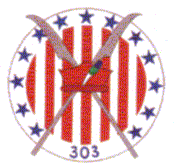
303
Warsaw Kosciuszko's Squadron
|
|
Mirek was officially discharged from the RAF
Volunteer reserve and rejoined the Polish Air Force in the United Kingdom
on 6th August 1940.
After various checks, including
aerobatics, formation flying, attack variants and air firing at Sutton
Bridge, he joined 303 Squadron on "B" flight on
12th August 1940. Six days later his colleague from Deblin, Jan Rogowski,
joined "A" flight. On 21st August, Witold Urbanowicz, the old
Commander of the Deblin Fighter Pilot School joined the squadron. |
Among
the original pilots were Jan Zumbach, Ludwik Paszkiewicz, Miroslaw Feric,
Witold Lokuciewski and Josef Frantisek, the Czech who had escaped with
them through Rumania.
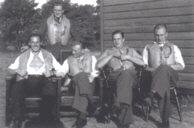
303
Squadron at Northolt Dispersal (from
left to right) Jan Daszewski, Mirek Wojciechowski(standing) Ludwik
Paskiewicz, Witold Lokuciewski, Waclaw Lapkowski
|
| Having been "seen on
arrival" (as Sqn Leader signed in his Log Book) Mirek started first solos in the squadron's
Hurricanes. Within days, pilots were training in formation. By mid
August, 11 Group had ordered 303 to maintain an airfield defence status;
this was hardly active duty. |
| On 30th August, Mirek was
flying as wingman to Ludwik Paskiewicz on a training exercise led by Sqn
Leader Kellet, intercepting six Blenheim bombers.
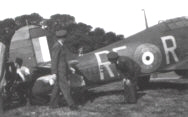
Hurricane
Mk I, P4175 RF-R, one of Mirek's aircraft also flown by Witold Lokuciewski |
Famously,
this incident is recorded in the film "The Battle of Britain",
although the 'babbling' of the Poles on the R/T is an unkind stereotype
that the film makers should have excluded. Claiming he was unable to raise
Kellet on the R/T, Paskiewicz peeled off, with the rest of the flight, in pursuit of German
aircraft.
Paskiewicz was credited with a
Dornier Do 17, officially reprimanded and told that he and the squadron
was now fully operational.
|
|
The 15th of September is widely regarded
as the turning point in the Battle of Britain. That morning, "B"
flight was scrambled at 11.20am, and directed to defend London. A vast German
armada had already flown up from the south and no concerted attack seemed
possible. It was every man for himself as individual dog fights broke out.
The squadron claimed 10 aircraft shot down from the sortie, of which
Mirek, as detailed in his Combat
Report, had destroyed an ME109E (also known as the Bf109) and shared a Dornier Do 215 with Sgt
Andruszkow. The squadron turned for home, to refuel and rearm.
Every Southern Sector Fighter Squadron
was being put up to meet the waves of German bombers. At 14.20pm, Mirek's
squadron was in the air again, this time sighting 400 bombers approaching
over Gravesend. Blue Section of "B" Flight, (Mirek and Walerian Zak led by Squadron Leader
Kellet), flew through the huge
enemy formation, followed by Urbanowicz leading Red and Yellow Sections.
The German aircraft broke formation and yet another series of dogfights
took place. Another 5 aircraft were claimed by 303 Squadron, with Mirek's Combat
Report detailing how he shot down
another ME109E.
During the day, the Luftwaffe launched
the largest daytime bombing raids of the war over England. The Luftwaffe lost 56 aircraft against 26 RAF fighters (of which 13 pilots survived). A
total of 27, or nearly half, of the total German losses were claimed by
Poles, of which 15,as detailed in the Intelligence
Report, were claimed by 303 Squadron.
|
| Sgt Andruszkow, who baled out
of his Hurricane that day, said later that aircraft were going down
everywhere. He feared that a piece of flaming wreckage would land on his
parachute. 7 of 9 aircraft landed back at Northolt in the afternoon; five
of them, included Mirek's, badly damaged. |
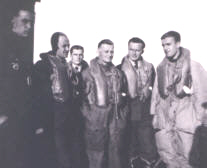
Dispersal,
September 1940 (left
to right) Josef Frantisek, Jan Kowalski,Miroslaw Wojciechowski, Ludwik
Paskiewicz, Marian Blec, Walerian Zak |
| German tactics changed again.
Smaller bomber concentrations, with much larger fighter escorts, were
launched on airfields and other valuable Fighter Command assets.
On 17th September, 303 Squadron were
patrolling with 1 RCAF Squadron. They saw Me109's over the Thames estuary, but at 27,000ft, they were
too hard to catch. Later, Mirek saw a Hurricane being pursued by three
Messerschmitts. He flew to engage them at 17,000 ft and shot one down.
According to his Combat
Report, he "could not follow the aircraft down, as he was engaged
with the others". However, Mirek did succeed in starting a fire in
the cockpit of the second ME109E but was again "unable to follow him
down, as I had another of them on my tail".

Mirek's Hurricane Mk 1 RF-U P3975 as
flown 17th September 1940
|
According to Robert Gretzyngier, Mirek
"probably saved the life of the Hurricane pilot, F/O E.C. Briese of 1
RCAF who was chased by the Messerschmitts; the oil system of his aircraft
suffered damage which prevented him from being able to reach Northolt and
he had to force land at High Halstow". |
On the 18th September, Mirek flew three
sorties and was almost certainly in the air when the squadron was bounced
by British fighters! Fortunately, only slight damage was done to two
aircraft. |
|
